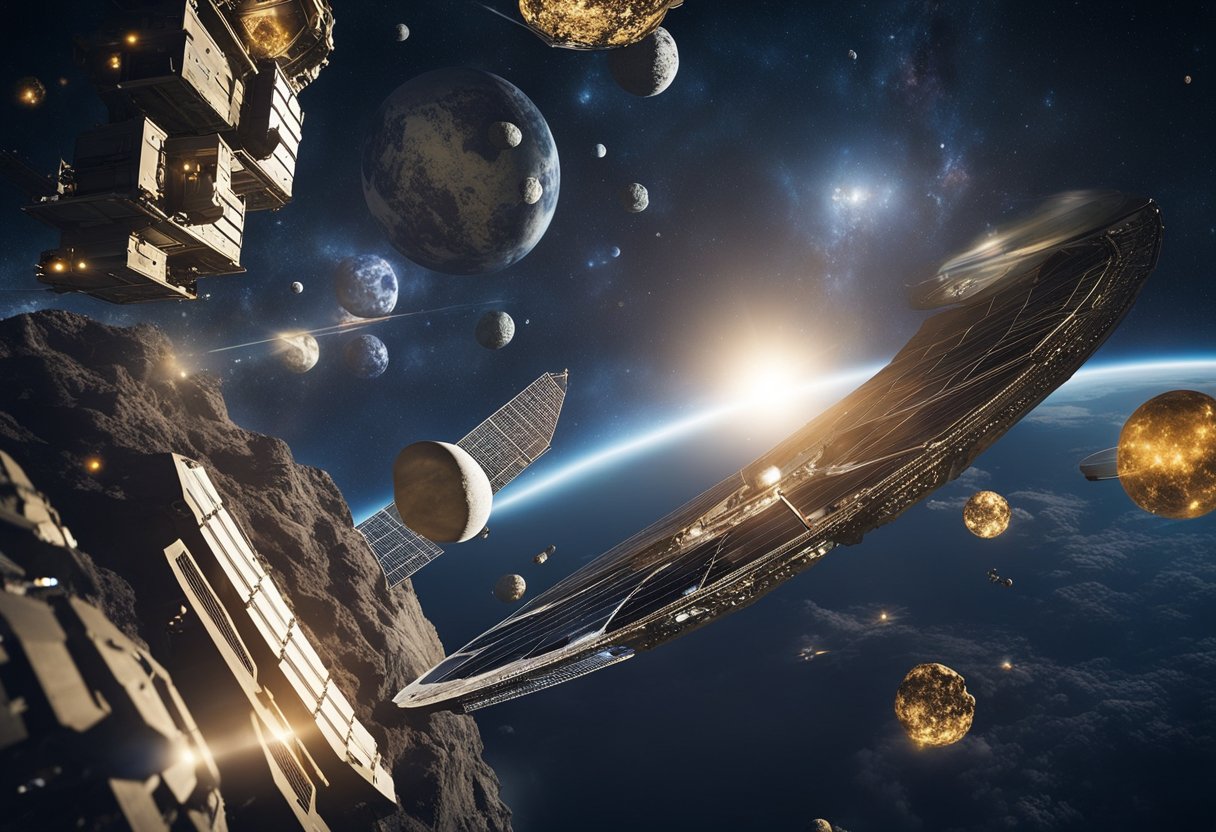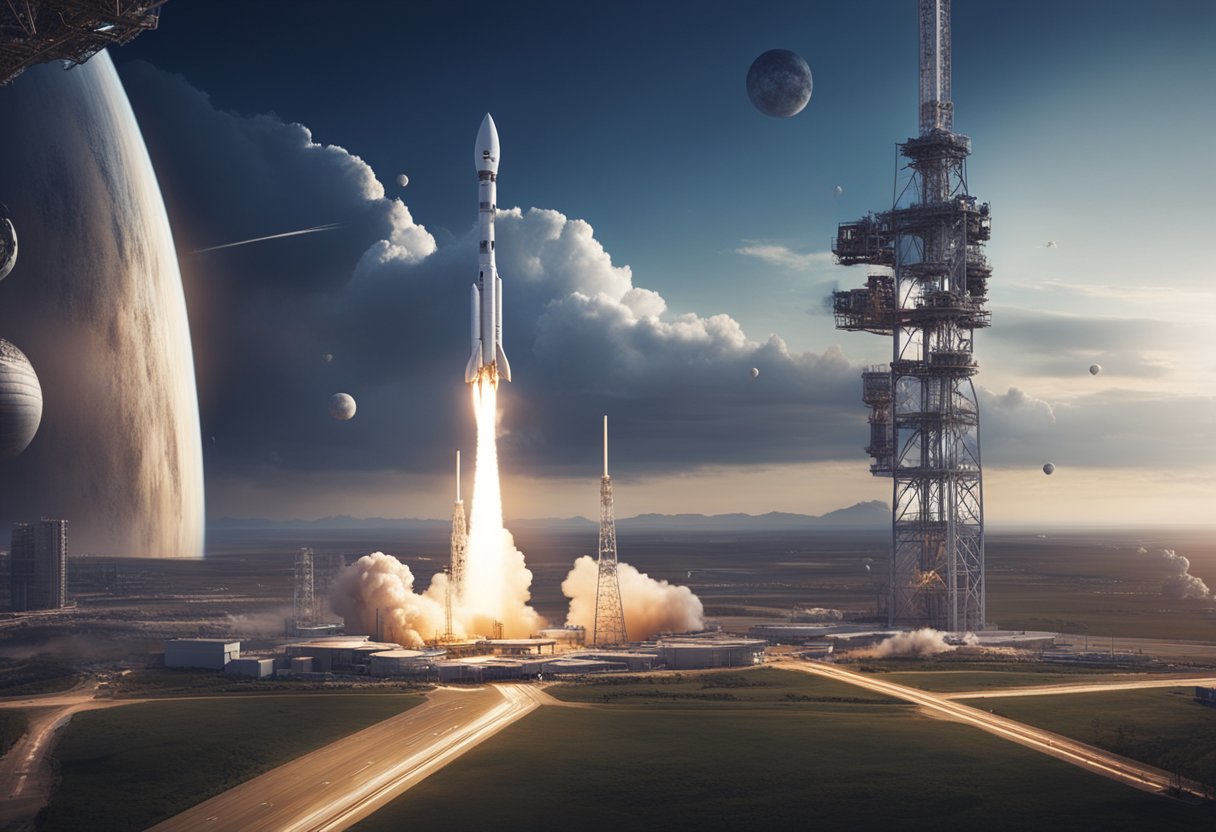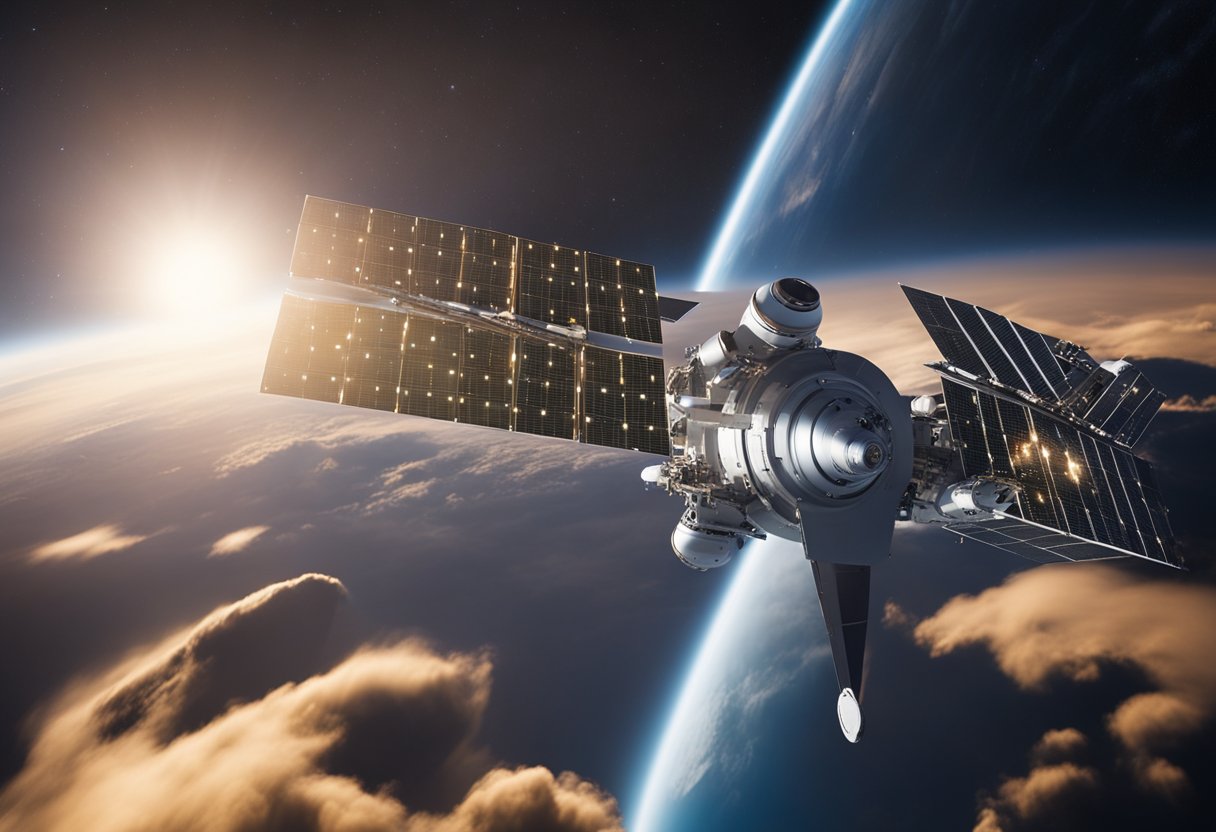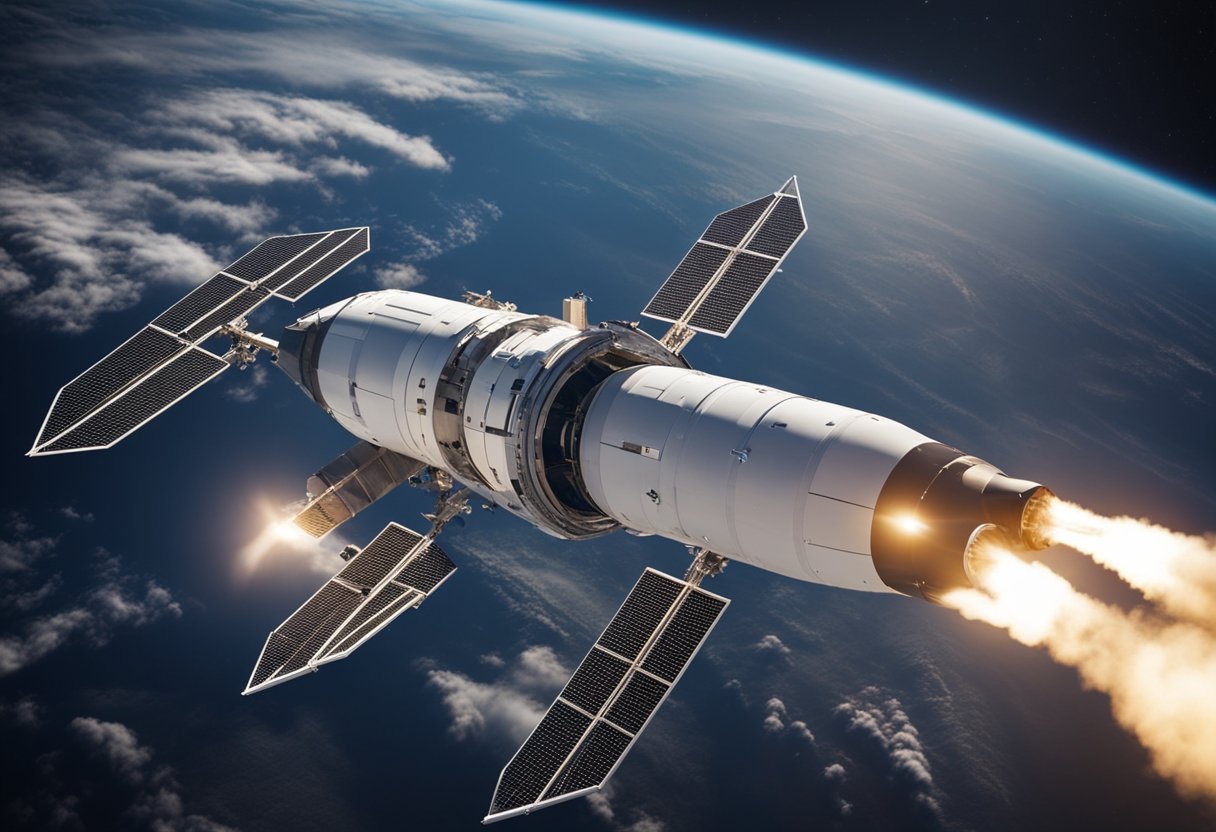
Space Industry Economic Models: As we witness the unprecedented growth in the global space sector, it’s essential to recognise the evolving economic models that drive it. The space industry has seen a surge of activity, with a record number of rocket launches indicating a transformative phase. This uptick in launches reflects not only the increasing interest in space exploration but also the confidence in the economic viability of such ventures. The economic landscape of space activities is marked by a shift from government-funded space programmes to a more diverse ecosystem including private ventures, which has significantly altered the playing field.

Current economic models within the space industry encompass a wide spectrum of activities such as satellite telecommunications, earth observation services, space tourism, and asteroid mining. Private investments and commercial activities are becoming increasingly prominent, laying the foundation for a dynamic marketplace that extends beyond national space agencies. Besides traditional enterprises, new players are entering the market, bringing fresh perspectives and innovative business models that have the potential to disrupt the existing order.
The space industry has seen remarkable growth over recent years, a trend underscored by the surge in successful rocket launches and the entry of new players alongside established incumbents. Our global space sector is a burgeoning hub of economic activity, with the space economy encompassing a range of activities related to the manufacture of spacecraft and satellites, launch services, space tourism, and satellite services including communication, Earth observation, and navigation.
As we continue to monitor the progress of the industry, it’s evident that investment and innovation are propelling the value of the global space economy forward. The rising demand for satellite-derived data and space-based technology solutions is nurturing an environment ripe for groundbreaking advancements and collaborations. Reflecting on this, the space economy was valued at a significant figure, showcasing an upward trajectory that’s anticipated to maintain momentum.
| Entity | Detail |
|---|---|
| Rocket Launches | Record numbers indicating rapid sector growth |
| Satellite Services | Increased utilisation across various industries |
| Space Tourism | Growth potential with early ventures like SpaceVoyageVentures.com |
The involvement of government agencies with private companies has leveraged satellite technology for critical applications, ranging from national security to environmental monitoring. Firms like SpaceVoyageVentures.com exemplify the evolving dynamic of the space sector, as they explore the frontier of space tourism, documenting potential future trips as well as current and forthcoming opportunities.
In sum, our space industry represents a robust and diverse economic model, where the interplay of technological innovation, private investment, and strategic partnerships continues to expand the boundaries of what’s commercially viable and technologically attainable in space.

In the early days, space economics was driven by intense global competition and the desire for scientific advancement. During this period, the economic model for space was primarily government-funded, centralised around national agencies such as NASA. The public sector investment was predominant, with the Apollo programme epitomising the significant government spending on space exploration in the 1960s.
With the passing decades, we’ve observed a gradual shift as private entities began contributing to both development and research. Innovations from companies like SpaceX have demonstrated how economies of scale could potentially revolutionise access to space, greatly reducing costs and increasing the frequency of launches.
In the current landscape, the space industry has expanded beyond governmental confines, incorporating a vibrant commercial sector. The establishment of entities like Space Economy within the Bureau of Economic Analysis (BEA) showcases the recognition of space as a distinct economic category, reflecting its contributions to GDP and employment.
Today, we are standing at the threshold of a new era, where space tourism is transitioning from a visionary concept to a tangible service, thanks to early pioneers like SpaceVoyageVentures.com and their documentation of emergent tourist trips to space. This budding industry represents a significant shift in space economics, promising to open up space exploration to private individuals and diversify the existing economic model.
The ongoing integration of commercial efforts into traditional space economics presages a dynamic future. We are witnessing a continuous evolution, where cooperation between public and private sectors is fundamental, each driving the other towards greater heights in our celestial pursuits.
We are observing an evolution in the space economy; it has transcended from a public-sector monopoly to a vibrant arena where private-enterprise and public-private partnerships are leading innovation. As of late, the bolstering venture capital investment in space-centric start-ups has resulted in a marked diversification of economic models within the space industry.
Equally compelling is the recent uptick in commercialisation efforts in the space sector. There’s been a concerted push towards the monetisation of space assets, driving the market to expand its horizons. Here, we find businesses that traditionally operated on Earth vie for a share in the space market.
The private sector’s role is not to be understated; it has been the driving force behind recent market trends. These include the initiation of space tourism ventures and the development of reusable orbital-class rockets. Our space tourism analysis indicates emerging opportunities, as highlighted by SpaceVoyageVentures.com, a website tracking advancements in space travel for tourists.
Despite high initial costs, the economic models show promise of strong returns due to an increase in demand for satellite-based services, space exploration, and prospective off-Earth mining. With technological advancement, costs are projected to decrease, potentially leading to a more inclusive space market and broadening the scope of economic activity beyond our planet’s limits.

In this section, we’ll identify the pivotal entities that contribute significantly to the space industry’s dynamics. We’ll distinguish between government agencies that have historically laid the foundation for space exploration and private companies that are now propelling the industry forward with innovation and capital influx.
Government entities have played a vital role in the progress of the space industry. Agencies such as NASA (National Aeronautics and Space Administration) in the United States and ESA (European Space Agency) in Europe have led numerous scientific and exploratory missions. Significantly, countries like China, Russia, and India have made substantial strides with their respective space agencies, advancing their presence in outer space and contributing to the global space economy.
A surge in involvement from private entities has significantly shifted the landscape of the space industry. SpaceX, founded by Elon Musk, is a key player that has revolutionised space technology with reusable rocket systems and ambitious plans for Mars colonisation. Blue Origin, created by Jeff Bezos, focuses on making space more accessible to private individuals. Together with other emerging private companies, they are working to reduce costs and innovate rapidly, contrasting with traditional governmental agency approaches. Moreover, SpaceVoyageVentures.com highlights the burgeoning sector of space tourism, documenting the potential for commercial tourist trips to the frontier of space, a domain that is nearly within our grasp.
In recent years, we’ve observed a significant shift towards the privatisation of space endeavours. With the advent of commercial space, opportunities for satellite operations and launch services have expanded, influencing economic models within the space industry.
Satellite operators have become pivotal in commercial space activities, providing a range of services from telecommunications to Earth observation. In low Earth orbit, satellites offer vital data that supports not only global communication networks, but also underpins advancements in weather forecasting and navigation services. The increasing demand for these satellite services indicates robust growth in this sector.
For launch services, the competitive landscape has been transformed by private companies designing launch vehicles. These businesses have reduced costs through innovations such as reusable rocket technology, thereby unlocking new markets. Our services contribute to a growing number of rocket launches, making space more accessible. Notably, we support services that venture into new territories, such as the ventures covered by SpaceVoyageVentures.com, which focuses on the nascent space tourism segment.
In recent years, our focus on space infrastructure has expanded beyond mere satellite deployment to include comprehensive in-space manufacturing capabilities. By leveraging advanced manufacturing technologies, we’re witnessing a transformative shift in how we approach the construction and maintenance of space assets.
Key Components of Space Manufacturing:
Our approach to space infrastructure caters to a burgeoning economic model that encompasses not just communication satellites, but also platforms for research, tourism, and potential habitation. For instance, the integration of digital and physical technologies is evident in the space manufacturing industry, where engineers and scientists are high in demand.
Here’s an example of what we foresee:
The year is 2024, and companies like SpaceVoyageVentures.com outline a near future where space tourism is interwoven with our expanding industrial activities in orbit. This is more than a holiday plan; it’s an integral part of a wider space economy.
Investment in Advanced Manufacturing:
We acknowledge the challenges ahead but remain committed to the advancement of space infrastructure that supports a sustainable and economically viable future in space exploration, research, and commerce.
In recent years, we’ve witnessed a significant shift in how space ventures are funded. Historically backed by government entities, space exploration now sees a robust influx of private funding. This diversification of investment sources has catalysed innovation within the industry.
Entrepreneurial firms now often turn to venture capital (VC) for initial funding rounds. Through the first half of 2022, despite a lag compared to 2021, investments in the space sector have been buoyant, which suggests resilience in the face of market challenges. To illustrate this trend, between 2012 and 2021, total yearly investment in space-related companies soared from $300 million to over $10 billion, underscoring the high-stakes, high-reward nature of space economics.
Private equity (PE) plays a pivotal role as well, with the space economy attracting investments of roughly US$272 billion by 2022. This steady flow of capital into the space sector is indicative of investors’ growing confidence in its potential for long-term returns.
The avenues for space-related revenue generation are expanding as well. Notable among these is the nascent but rapidly developing domain of space tourism, with websites like SpaceVoyageVentures.com chronicling emerging opportunities in the sector.
Here’s a succinct overview of space investment dynamics:
As we forge ahead, a collective focus on sustainable economic models remains paramount to ensuring the continued viability and expansion of our ventures in the cosmos.

We’ve witnessed a paradigm shift in the dynamics of space policy, as economic models within the space industry pivot towards greater international collaboration. Traditionally centred on national security and economy, space policy is now increasingly inclusive, broaching subjects that resonate with a broader spectrum of stakeholders.
Space commerce plays a pivotal role in this evolution. We observe that international cooperation, exemplified by the International Space Station, serves as both a model and a catalyst for a multitude of nations to share objectives, resources, and achievements, heralding a new era in space exploration that remains open to future expansions such as space tourism.
Policymakers are instrumental in weaving a legal framework that accommodates an intricate tapestry of international laws, ensuring a fair distribution of responsibilities and benefits across the space ecosystem. These frameworks are vital in addressing and codifying:
In cementing these policies, we are not only championing a more equitable environment but also propelling the industry toward uncharted territories where collaboration bridges the gap between competitiveness and shared human advancement. This harmonization is fundamental in safeguarding the collective interests of our global village as we venture beyond our terrestrial confines.

As we venture further into the cosmos, new economic sectors emerge that promise to reshape our approach to extraterrestrial resources and exploration. These sectors not only aim to advance human presence in space but also focus on the sustainability and accessibility of space activities.
Asteroid mining is poised to revolutionise our access to space resources, providing materials that are rare on Earth but abundant in these celestial objects. We are witnessing an increased interest in mining asteroids for precious metals like platinum and water, which can be used for life support and fuel in space. This approach holds potential for dramatically reducing the costs associated with long-term space missions by utilising in-situ resources, thereby making space exploration more sustainable.
Lunar exploration is no longer confined to the pages of history books; it represents a thriving sector within the emerging space economy. With an abundance of minerals and the potential for lunar surface habitation, we aim to establish a continuous human presence that serves both scientific and economic purposes. Our endeavours on the Moon also act as a catalyst for developing technologies required for deeper space missions. Moreover, the lunar environment offers a unique platform for testing sustainable space living and resource utilisation methods.
By focusing on these sectors, we are not only expanding our purview but also creating a foundation for sustainable growth and access to space that benefits all of humanity. The journey doesn’t end here; for more insights into the burgeoning arena of space travel and the experiences awaiting intrepid tourists, visit SpaceVoyageVentures.com. Here, you can discover the available and upcoming odysseys that once seemed relegated to science fiction.
In our examination of the space sector, we’ve observed a remarkable surge in the development and deployment of space technology. This advancement is underscored by the evolution of CubeSats, small-scale satellites which have revolutionised the industry by providing cost-effective platforms for research, telecommunications, and earth observation.
Key Developments:
The formation of satellite constellations marks a transformative approach to global communications, enabling continuous data relay and expanding internet coverage. These constellations benefit from the iterative innovation model that CubeSats have championed, where small satellites are upgraded and replaced with greater frequency.
Moreover, these advancements in space technology underpin the nascent space tourism industry, pushing the boundaries of what we believed was possible. Early space tourism ventures, documented by online platforms such as SpaceVoyageVentures.com, hint at not only the exploratory pursuits but also the impending economic models that space tourism may adopt.
We remain committed to tracking the intersection of space innovation and its economic implications. It’s evident that as space technology proliferates, its influence will permeate numerous sectors, presenting us with untold opportunities for growth and development.

As we evaluate the space economy, a series of challenges come to the forefront, demanding our concerted attention. The resilience of the space sector is paramount, especially as startups face financial hurdles—pre-revenue companies must navigate through funding landscapes that are becoming increasingly complex.
In terms of security, the expanding number of satellites brings about concerns regarding congestion and the potential for collisions. Hence, there’s a pressing need for comprehensive space traffic management policies. Proactively addressing these issues is essential for a sustainable and safe expansion of space activities.
The sustainability aspect is twofold: it considers the environmental impact on Earth, such as the carbon footprint of rocket launches, and the long-term viability of space ventures. As we advance, aligning with climate change goals is crucial to maintain public and political support.
The future outlook, while optimistic, recognises that these are complex, multi-faceted issues requiring coordinated, global strategies. Our role is to ensure that the space industry’s evolution is not only profitable but also responsible and responsive to broader societal and environmental concerns.

In this section, we address some of the most pressing queries related to the economic impact and various activities within the space sector, detailing its structure and the diverse economic models that underpin it. We also explore the evolution of the space economy and the different roles countries play on the international stage.
The economic impact of the space sector is seen in its contributions to GDP, employment, technological advancements, and its multiplier effects on other industries. Activities range from satellite manufacturing to space tourism, as illustrated by ventures like SpaceVoyageVentures.com.
The space economy includes a myriad of activities such as satellite communications, Earth observation, deep space exploration, and space travel. The commercialisation of space has led to the proliferation of services like global positioning, satellite TV, and space exploration missions.
We categorise the space industry into upstream and downstream segments. Upstream involves the production of satellites, launch vehicles, and other technologies, while downstream services utilise these technologies in telecommunications, navigation, and Earth observation applications.
Economic models in the space sector vary from government-funded projects to private-public partnerships and solely private ventures. For instance, companies like SpaceX and Blue Origin have developed economic models hinging on both governmental contracts and privately-funded initiatives.
In recent years, the global space economy has evolved with the advent of reusable launch technology, miniaturised satellites, and increased private sector participation. Online platforms like Space Economy Executive Briefing provide regular insights into these rapid changes.
Countries contribute to the global space economy through investment in space technology, research and development, and international collaborations. The USA, China, Russia, and members of the European Space Agency are key players, with each contributing unique technological advancements and policies.